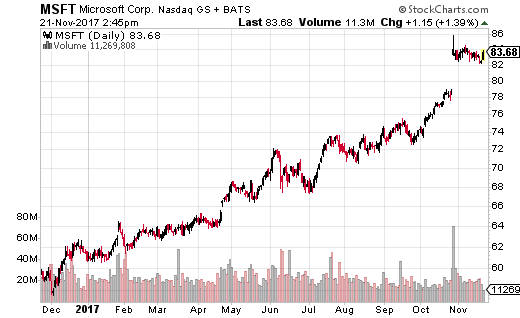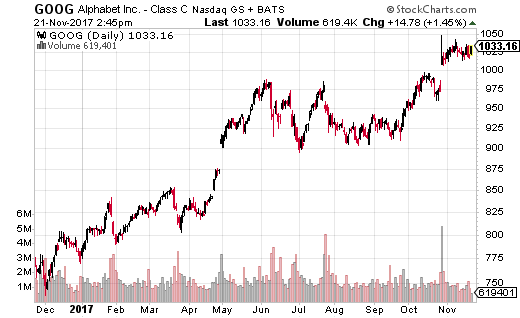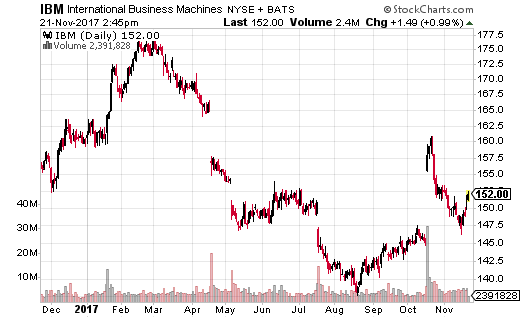But that doesn’t mean that I don’t love wandering around my father’s property as he points out his various plants and new projects.
From spring through fall, nearly every time I visited, he would have something new to show me as we walked the yard. Or “toured the lower 40,” as he calls it.
“Why all the moving around?” I asked him when he pointed out a set of hostas that had been split and spread to a new shaded bed.
“It’s about balance, Joce.” The giant blue hostas had spread and were threatening to take over their previous flower bed so that nothing else could grow.
While my father might have been talking about rebalancing his green space, that same idea can be extended to your own investment portfolio. And it’s more critical than you might realize. Rebalancing could mean the difference between surviving the next market collapse…
The stock market has put in a solid performance in 2017 despite endless talk of stocks being overvalued (which they very likely are) and bubbles expanding in several sectors (and they are).
The fact is that if you stuck with stocks in 2017, you are sitting on some nice gains.
The Dow Jones Industrial Average has gained 20% this year, and the tech-laden Nasdaq Composite is up roughly 19%. Even the small-cap Russell 2000 Index has rallied 12%.
In the commodity space, oil has tacked on 7%, and gold has grown an impressive 12% despite strength in stocks.
But those nice gains have created a serious problem within your portfolio, and it’s important that you address it sooner rather than later before a market collapse. It’s a good time to take a hard look at all those eggs you’ve gathered and figure out exactly how you’re going to redistribute them across many baskets.
It’s called rebalancing, and it’s going to be the key to keeping your wealth growing in the new year.
Rebalance and Stay Safe During a Market Collapse
We’ve all heard the old adage time and time again: “Don’t put all your eggs in one basket.”
And you haven’t.
You’ve wisely distributed your investments across a variety of sectors, investment vehicles, and possibly even countries and currencies.
Ted Bauman, editor of The Bauman Letter, has addressed the proper distribution of your investing portfolio across stocks, currencies, commodities and even rare tangible assets on numerous occasions in his newsletter. (He has also given tips on different asset protection strategies you can use for unique ways to grow your retirement nest egg. Don’t miss out!)
But the problem that occurs when you have different investments growing at different “speeds,” is that your distribution across many baskets becomes more lopsided than you intended.
Let’s look at an example.
Say you started with a portfolio of $100,000, and you distributed as follows:
- Aggressive tech stocks — 50% ($50,000).
- Blue-chip stocks — 20% ($20,000).
- Foreign stocks — 20% ($20,000).
- Gold bullion — 5% ($5,000).
- Commodities — 5% ($5,000).
Now keep in mind, I’m not saying this is how you need to distribute your portfolio. I’m just using nice, round numbers to keep the math easy. You should really check out The Bauman Letter for tips on how to balance your investments.
But let’s assume that you’ve had a great year of stock picking and your tech stock positions are up 65%, your blue-chip stocks are up 20%, gold is up 12% and commodities are up 7%. Foreign stocks struggled a bit for you and are flat.
That means your portfolio is now worth $137,450.
- Aggressive tech stocks — $82,500, or 60% of your portfolio.
- Blue-chip stocks — $24,000, or 17.5% of your portfolio.
- Foreign stocks — $20,000, or 14.6% of your portfolio.
- Gold bullion — $5,600, or 4.1% of your portfolio.
- Commodities — $5,350, or 3.9% of your portfolio.
As you can see, by just being a great stock picker and riding the rally in the various sectors, your portfolio has shifted over the past year to favor aggressive tech stocks more than you had intended. What’s more, your exposure in safe haven areas such as blue-chip stocks and gold have shrunk significantly. That could put your portfolio in dangerous territory should the market collapse in 2018 with tech stocks once again leading the way lower.
A Time to Explore New Investments
The end of the year is a great time to step back and examine your investment portfolio. If you’ve enjoyed some stellar gains this year, then you might need to take some money off the table and move it to other investments so that you remain protected against an unexpected turn in the market.
Rebalancing your portfolio keeps you in the game longer. It also gives you a chance to explore new investment avenues that maybe you didn’t have the capital to invest in a year or two ago.
Is it time to potentially move some of your funds out of stocks and into rare tangible assetssuch as stamps, art or rare coins?
Is it time to look in to real estate as a way to protect and grow your wealth?
Or maybe you need to add more income to your portfolio? Matt Badiali has just released a special report that offers an easy way to add a steady flow of income to your portfolio without using options. (You can check out his special report here.)
As we head into the final month of 2017, closely examine your portfolio. Take the time to rebalance. Don’t let it run wild. Prune it back in the right places and reap the benefits year after year.
Regards,

Jocelynn Smith
Sr. Managing Editor, Sovereign Investor Daily
It’s not silver or platinum. It’s not aluminum, nickel or lithium, either. But this “magic” METAL is found in everything from cars to airplanes, smartphones and computers, even batteries and cosmetics. It even has the power to fight diabetes, depression, weight loss and cancer. It’s worth billions, even trillions. But here’s the problem—this metal is disappearing. The world’s reserves are quickly being sucked dry. But a group of geologists have just struck the motherlode, and the one company behind it could earn investors an absolute fortune as they solve the greatest commodity crisis in human history. [FOR MORE INFORMATION CLICK HERE]
Source: Banyan Hill


 Luckily, a number of the top U.S. technology companies are working hard on scaling up quantum computing technology. The companies involved in this ‘arms race’ include as I mentioned Microsoft (Nasdaq: MSFT) as well asAlphabet (Nasdaq: GOOG) and IBM (NYSE: IBM).
Luckily, a number of the top U.S. technology companies are working hard on scaling up quantum computing technology. The companies involved in this ‘arms race’ include as I mentioned Microsoft (Nasdaq: MSFT) as well asAlphabet (Nasdaq: GOOG) and IBM (NYSE: IBM). 
